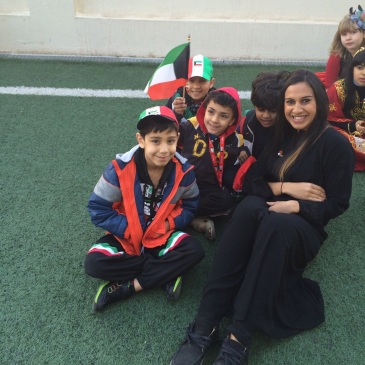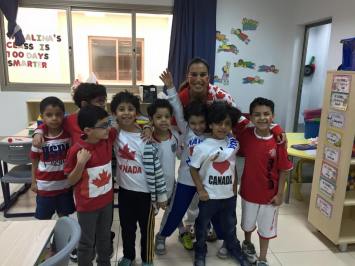Alina Daya is an educator by profession, and recently completed her Masters in Teaching (MTeach) degree at the University College London (UCL). Her dissertation looked at the impact of a positive emotional learning environment in a classroom, and the research was conducted in a classroom of Grade 8 students at a supplementary school in Toronto, Canada, part of a network of religious education centres run by the Ismail community. Ms Daya used existing literature to establish what a positive emotional learning environment looked like. She then used questionnaires, focus groups and student journals to gain a student perspective on what best supports them in their education. There is a wide spectrum of research on how the physical space can hinder or enhance student learning, however there is very little research that focuses on the emotional learning space, and the factors that contribute to it. The literature suggests that there are certain needs that students require in order to thrive in their educational settings. This study found that by creating an emotionally positive and secure environment, student learning was enhanced, students were more confident, and that participation in classroom activities and discussions increased. However, Ms Daya’s initial research focus changed as she worked on her inquiry, and she found herself focusing heavily on the impact of student teacher relationships and how those specifically contributed towards student learning. Daya also noted several key factors that impacted the intangible classroom environment: she concluded that although physical and social spaces are significant elements that contribute towards student learning, emotional environments are just as vital to establish in any given classroom.
Like most people who go through any type of formalized education, there are always the teachers that stand out to us and change our lives in some way. You may not have come across yours yet, but I have, and I will never forget her. She was the one who inspired me to go into teaching. I say this because it was the first time I had been in a classroom that made me eager to learn. When I think back to all my years spent as a student, I look at the many different teaching styles that had come my way. Many spoke to me, and likewise, many did not.
 After realizing that I wanted to pursue a career in education, I completed my first Bachelor’s Degree in Religious Studies at Queen’s University. I then applied and received my second Bachelor’s degree, in Education (B. Ed) from the same university. As soon as I completed my B. Ed, I packed up my bags and moved to the Middle East. Yes, that’s right, I moved to a beautiful country called Kuwait. I worked for an American-based school in Salamiya for three years and it was there that I learned about what type of teacher I wanted to be. It was a learning process, but over the years it slowly came together. One of the things I realized throughout my teaching practice was that if my students were happy in the classroom, their work would be impacted in a positive way. If my students were unhappy, their motivation to learn would decrease. I wondered how true this was, and I knew that there was no tangible way to measure the impact of happiness on student work, but it definitely got my attention.
After realizing that I wanted to pursue a career in education, I completed my first Bachelor’s Degree in Religious Studies at Queen’s University. I then applied and received my second Bachelor’s degree, in Education (B. Ed) from the same university. As soon as I completed my B. Ed, I packed up my bags and moved to the Middle East. Yes, that’s right, I moved to a beautiful country called Kuwait. I worked for an American-based school in Salamiya for three years and it was there that I learned about what type of teacher I wanted to be. It was a learning process, but over the years it slowly came together. One of the things I realized throughout my teaching practice was that if my students were happy in the classroom, their work would be impacted in a positive way. If my students were unhappy, their motivation to learn would decrease. I wondered how true this was, and I knew that there was no tangible way to measure the impact of happiness on student work, but it definitely got my attention.

As I continued to reflect on this, I decided to continue my own education and pursued a Master’s degree at the University of College London (UCL). While completing my Masters in Teaching degree at UCL, I had the opportunity to conduct an action research project in Toronto, Canada. The school that I was placed in was a Religious Education Centre for the Shia Ismaili Muslim community, and this research was conducted over a period of ten weeks. This was my opportunity to look at how a student’s emotional learning environment impacted their learning. I also looked at the tangible learning environments such as the physical space, however my interests were engrossed in how emotional learning environments impacted student motivation and behaviour.
The first step I made was to try and define what an emotional learning environment is. The current literature dedicated to emotional learning environments is limited, which made it difficult to define. I used literature and articles based on ‘emotional classroom climates’ and a combination of different learning theories to come up with a concrete definition of what a positive emotional learning environment entails.
Aydogan’s (2012) definition of what an emotional learning environment was used as the working definition throughout this dissertation. Aydogan (2012) defines an emotional learning environment as “the extent to which the teacher displays positive (warm and respectful) or negative (anger, sarcasm, and irritability) emotions toward children, how sensitive he/she is to children’s levels of academic and social functioning, as well as how responsive he/she is to the needs of children in these areas of functioning determine the level of emotional support provided to children” (p.18).
 Although my research is limited, I believe that it is a gateway into researching the intangible type of learning environment: the emotional one. Reading the existing literature pertaining to this field guided me towards creating my own checklist that defined what I thought a positive emotional learning environment looked like. It outlined different practices and pedagogies that I wanted to execute in the classroom. I had made conscious efforts to implement things that were on the checklist in every class taught throughout my research process and afterwards. After implementation, I realised I needed to come up with a way to see if it was possible to measure its impact on my students. In order to measure this, students participated in questionnaires, focus groups and writing journals that consisted of reflections based on their in-class experiences. After collecting and analysing the data, I realised that students appreciated kind gestures in the classroom, and noticed the language that teachers use. They discussed past experiences in their focus groups, and remembered ‘negative’ terminology and tones that teachers would use to address students. The fact that these ‘negative’ memories stuck with them over a period of time only reinforced the fact that terminology has the power to positively or negatively impact the student-teacher dynamic. It has monumental impacts for their relationships, which can influence student motivation and engagement levels inside the classroom.
Although my research is limited, I believe that it is a gateway into researching the intangible type of learning environment: the emotional one. Reading the existing literature pertaining to this field guided me towards creating my own checklist that defined what I thought a positive emotional learning environment looked like. It outlined different practices and pedagogies that I wanted to execute in the classroom. I had made conscious efforts to implement things that were on the checklist in every class taught throughout my research process and afterwards. After implementation, I realised I needed to come up with a way to see if it was possible to measure its impact on my students. In order to measure this, students participated in questionnaires, focus groups and writing journals that consisted of reflections based on their in-class experiences. After collecting and analysing the data, I realised that students appreciated kind gestures in the classroom, and noticed the language that teachers use. They discussed past experiences in their focus groups, and remembered ‘negative’ terminology and tones that teachers would use to address students. The fact that these ‘negative’ memories stuck with them over a period of time only reinforced the fact that terminology has the power to positively or negatively impact the student-teacher dynamic. It has monumental impacts for their relationships, which can influence student motivation and engagement levels inside the classroom.
This research has inspired me to make conscious efforts in creating a positive emotional learning environment in my classroom. This practice is one “that encompasses moral behaviour and positive emotions that benefit students in non-tangible ways” (Daya, 2017). I have been fortunate enough to have witnessed firsthand how this pedagogy impacts student learning and motivation inside the classroom. I am hopeful that this new piece of literature will attract other educators to focus on creating a positive emotional learning environment in their classrooms.
Aydogan, 2012. Influences of Instructional and Emotional Classroom
Environments
and Learning Engagement on low-income children’s achievement in the
prekindergarten year. Doctor of Philosophy. Dissertation, Graduate School of
Vanderbilt University.
Daya, 2017. The Role of a Positive Emotional Learning Environment in a Secondary
Religious Education Classroom in Toronto Canada. Masters of Teaching
Dissertation. University College London.

alina.daya@gmail.com FINALDISSERTATIONAlinaDayaMTeachPBEFinalDissertationAug22

Cutting edge research, congratulations Alina!!
As a university lecturer, I have been doing this in my tutorials without realising it had a “name”. Students need to feel safe to engage in discussion and ask any question they wish, without feeling judged. A climate of collegiality within the classroom also needs to be nurtured.
Would love to have a copy of your dissertation.
Bashir.
b.sumar@uws.edu.au